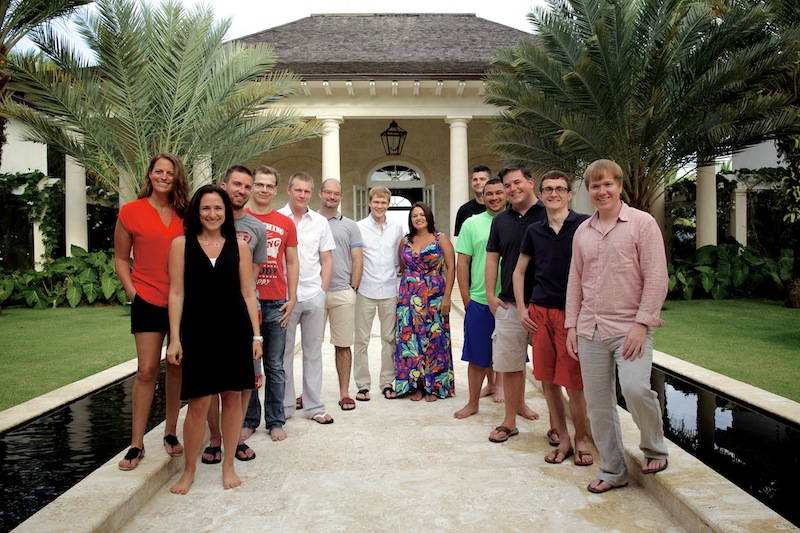Name: Chris Nagele
Title: Founder
Company: Wildbit
Established: 1999
Employees: 15 (10 local; 5 remote)
37signals user since: February 2004
Wildbit creates and supports web products that help businesses collaborate and communicate more effectively. Their main products are Beanstalk, a hosted service offering Git and SVN version control, collaboration tools and instant deployments for web apps, and Postmark, which helps businesses deliver and track transactional emails. Wildbit is among 37signals’ earliest customers, so it was an honor to speak with founder Chris Nagele about his company and how they use 37signals products. The interview has been edited for length and clarity.
You’ve been a Basecamp user since the product first launched, in 2004. Do you remember how you first discovered it?
I used to follow the 37signals blog before they did products, back when Jason was doing the 37better project. They would do something like, “here’s FedEx’s home page and what it looks like now, and here’s our take on what it would be if we designed it.” It was a really good way to show off their skills and build some marketing around it. I started following the blog and when they launched Basecamp, I thought it was a cool product and signed up.
What did you use Basecamp for, at first?
Wildbit was completely different from what it is today. Back then we used to build products or applications for other people, so we were mainly just a consulting company — we were using it to manage our projects with clients. It wasn’t until late 2009 that we switched away from consulting and focused on our own products.
When you’re building products for other clients, there’s much more of a service toward communicating with the client, to make sure they always know where you are in the project, how far along you are, whether you’re getting into scope creep or the project is going to cost more. So there’s more accountability in terms of communicating with clients or customers as you’re building the project. We would have milestones and a lot of to-do lists, and a lot of the discussion was around getting approval on certain concepts or discussing roadmaps and things like that.
We don’t do consulting anymore at all. It’s very similar to what 37signals did, where they built and designed products for other people, and then as their own products grew decided to focus on them 100 percent. That’s kind of the same path that we went.

What kinds of projects have you managed with Basecamp over the years?
We have two main products. The high-level description of what our products do is they allow software developers to collaborate more effectively.
One is called Beanstalk and it’s a version control and deployment service. Software developers around the world use it to collaborate as they build software and write code, and then as they write code and builds the products, they use Beanstalk to review and discuss with their team. Once it’s something that’s ready to deploy to servers and their customers, they also use Beanstalk to ship the code out to their customers.
Postmark is more of an infrastructure product. It allows software developers to send all their application email through Postmark, to make sure that they’re delivered to the inbox. Initially it sounds like an easy thing to do, but if you’re sending things like invoices or welcome emails or password resets or comment notifications like in Basecamp, getting an email to the recipient is extremely important. There’s a lot that goes on in the background.
So you used Basecamp to build both products?
Absolutely, yeah. As we were building Beanstalk — especially in the early days before bug tracking systems and things like that — we used Basecamp primarily to discuss the new features we were working on, to schedule milestones and to-do lists, roadmap planning, all of that. It’s interesting that the new Basecamp has evolved into less of a project management tool and more of a communication tool, because that’s how we evolved into using it anyway.
Can you give me an example of how you’re using Basecamp as a communication tool these days?
One thing we did for the summer was called ‘quiet days.’ We said ‘let’s set Monday through Thursday as regular work days, and then every Friday we’ll call it a quiet day.’ It’s a day you can work on something that’s not related to our road map, whether it’s reading a book on a new programming language or a new design process, or working on an open source project. So every Friday everybody would work on something they were interested in, and on Monday they would go into Basecamp and post what they did that day, what they learned. Basecamp was huge for that because they would post something they worked on, present it to the team, and the whole team would say ‘this is awesome!’ or discuss different ways to use it. A lot of ideas and new features came out of those quiet days.
How has your use of 37signals products evolved over time?
These days, since we’re focusing our own products, I would say the biggest difference is that we have different systems for managing tasks and bugs and things like that, and we primarily use Basecamp for communication and ideas. So as new ideas come up, or as we’re planning things internally in the company, we’ll use Basecamp to discuss them or plan around the calendar. It’s much more discussion-based than it is milestone or project planning.
We’re not using Basecamp Classic anymore because we never really did time tracking. We got completely away from milestones. These days it’s more for internal communication: vacation days in the calendar, any internal policies we have, project ideas and stuff like that.
We’re starting to use Highrise, because we started doing more customer development. Beanstalk is almost six years old; it’s grown very organically. We don’t do much advertising, we don’t really do any marketing, and we’re just now starting to say, ‘what else can we do?’ And that’s where Highrise came in — all these customers use us, and the only time we talk to them is when they have a problem. I want to reach out to customers more when they’re not having a problem. I just want to hear from them. So we’ve started to use Highrise a lot more to kind of keep a log as we reach out to customers — who they are, what they do, are they launching a product soon? And if they are, maybe we can congratulate them on that and send them stuff on their first anniversary.
What’s your work environment like, and how do 37signals products contribute to your culture?
Back when we started using Basecamp we were a 100 percent remote company. It was just myself and my wife here in Philadelphia, and the rest of our team was in Bulgaria, in Serbia, Russia, Ukraine, Germany — really, our entire team was spread out. Since we’re all not sitting in the same office, we use Campfire as that way to feel like we’re all together in the same room. We used Basecamp to communicate, and with a remote team that was extremely important. If somebody had an idea or wanted to discuss something they could do that while we were sleeping and then we could wake up and continue the discussion.
These days we actually have most of our employees in Philadelphia, but our use of tools like Basecamp and Campfire hasn’t changed. Even though we are all in the same office, we still carry the remote team mentality of respecting each other’s quiet time. By using Basecamp, we can post messages and request feedback that people can respond to when they have time, instead of yelling across the room or walking up to their desk. The funny side effect is that our office can be eerily quiet during the work day. A remote team has been a big part of our culture and tools like Basecamp make that process possible, even when some of us might be sitting right next to each other. But that’s been an interesting transition for us. You’re used to remote work all the time and being on your own, and now you have to actually interact with people!
It’s been such a crazy experience for us to have people in the same room, but also maintain the benefits of a remote culture. We used to really enjoy quiet time all day long, and now with everybody in the office, it’s productive but at the same time you kind of find it hard to escape sometimes.
That’s kind of the opposite path a lot of companies are taking now, going from remote to an office versus the other way around.
Totally, yeah. I think there’s tons of value in remote work, and I think it’s really important that people understand the value in it. But there’s also tons of challenges in it as well, but you can’t figure them out until you try it.
What kinds of challenges did Wildbit face?
The biggest challenge for us has always been hiring the right people to fit into our culture, especially being remote. When you’re hiring remote people you have to hire someone who is really a self starter — kind of a mix between an entrepreneur and somebody who wants to work for a company. Finding that type of person is really difficult. Over the years, we’ve definitely learned how to build and grow a remote a remote company better, but with a lot of trial and error as well.
What discoveries have you made about that process?
Being able to know when somebody either doesn’t fit in with the culture or isn’t working out — a lot of times that process is a lot more delayed than when you’re sitting next to somebody in the office, or working with them day to day. Trying to pick up on those cues through things like IM and Campfire and tools like Basecamp is a little more difficult, but over time you start to understand personality through more digital communication.
Visit Wildbit.

This discussion is closed.